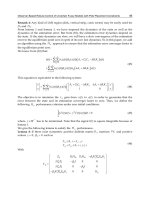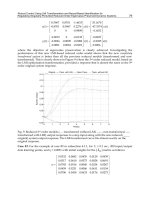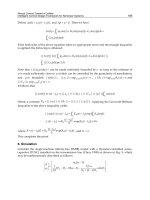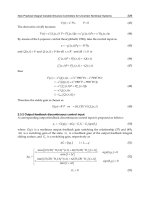Advances in linear matrix inequality methods in control
Bạn đang xem bản rút gọn của tài liệu. Xem và tải ngay bản đầy đủ của tài liệu tại đây (11.09 MB, 121 trang )
www.pdfgrip.com
Advances in Linear
Matrix Inequality
Methods in Control
www.pdfgrip.com
Advances in Design and Control
SIAM's Advances in Design and Control series consists of texts and monographs dealing with all
areas of design and control and their applications. Topics of interest include shape optimization,
multidisciplinary design, trajectory optimization, feedback, and optimal control. The series focuses
on the mathematical and computational aspects of engineering design and control that are usable
in a wide variety of scientific and engineering disciplines.
Editor-in-Chief
John A. Burns, Virginia Polytechnic Institute and State University
Editorial Board
H. Thomas Banks, North Carolina State University
Stephen L. Campbell, North Carolina State University
Eugene M. Cliff, Virginia Polytechnic Institute and State University
Ruth Curtain, University of Groningen
Michel C. Delfour, University of Montreal
John Doyle, California Institute of Technology
Max D. Gunzburger, Iowa State University
Rafael Haftka, University of Florida
Jaroslav Haslinger, Charles University
J. William Helton, University of California at San Diego
Art Krener, University of California at Davis
Alan Laub, University of California at Davis
Steven I. Marcus, University of Maryland
Harris McClamroch, University of Michigan
Richard Murray, California Institute of Technology
Anthony Patera, Massachusetts Institute of Technology
H. Mete Soner, Carnegie Mellon University
Jason Speyer, University of California at Los Angeles
Hector Sussmann, Rutgers University
Allen Tannenbaum, University of Minnesota
Virginia Torczon, William and Mary University
Series Volumes
El Ghaoui, Laurent and Niculescu, Silviu-lulian, eds., Advances in Linear Matrix Inequality Methods
in Control
Helton, J. William and James, Matthew R., Extending H°° Control to Nonlinear Systems:
Control of Nonlinear Systems to Achieve Performance Objectives
www.pdfgrip.com
Advances in Linear
Matrix Inequality
Methods in Control
Edited by
Laurent El Ghaoui
University of California, Berkeley
Silviu-lulian Niculescu
Universite de Technologie de Compiegne
Compiegne, France
slam.
Society for Industrial and Applied Mathematics
Philadelphia
www.pdfgrip.com
Copyright © 2000 by the Society for Industrial and Applied Mathematics.
1098765432 1
All rights reserved. Printed in the United States of America. No part of this book may be
reproduced, stored, or transmitted in any manner without the written permission of the
publisher. For information, write to the Society for Industrial and Applied Mathematics,
3600 University City Science Center, Philadelphia, PA 19104-2688.
Library of Congress Cataloging-irvPublication Data
Advances in linear matrix inequality methods in control / edited by
Laurent El Ghaoui, Silviu-lulian Niculescu.
p.cm. — (Advances in design and control)
Includes bibliographical references.
ISBN 0-89871-438-9 (pbk.)
1. Control theory. 2. Matrix inequalities. 3. Mathematical
optimization. I. El Ghaoui, Laurent. II. Niculescu, Silviu-lulian.
III. Series.
QA402.3.A364 2000
629.8dc21
99-39162
,ãô
ELlcUTL is a registered trademark.
www.pdfgrip.com
Contributors
R. J. Adams
C. Andriot
P. Apkarian
V. Balakrishnan
E. B. Beran
S. Boyd
S. Dasgupta
C. E. de Souza
S. Dussy
L. El Ghaoui
E. Feron
Electrical Engineering Department,
University of Washington, Seattle, WA 98195
Internet: rj adamsQuwashington. edu
Service Teleoperation et Robotique, CEA,
route du Panorama, 92 265 Fontenay aux Roses, France
Internet: andriotQCYBORG. cea. fr
CERT/DERA,
2 Av. Ed. Belin, 31055 Toulouse, France
Internet: apkarianflcert.fr
School of Electrical and Computer Engineering,
Purdue University, West Lafayette, IN 47907-1285
Internet: raguQecn. purdue. edu
Axapta Financials Team,
Damgaard International A/S
Bregneroedvej 133, DK-3460 Birkeroed, Denmark
Internet: ebbQdk. damgaard. c om
Information Systems Laboratory,
Electrical Engineering Department,
Stanford University, Stanford, CA 94305
Internet: boydQst anf ord. edu
Department of Electrical and Computer Engineering,
University of Iowa, Iowa City, IA 52242
Internet: soura-dasguptaQuiowa.edu
Laboratorio Nacional de Computagao Cientffica-LNCC,
Department of Systems and Control,
Av. Getulio Vargas, 333, 25651-070 Petropolis, RJ, Brazil
Internet: csouzaQlncc.br
Aerospatiale-Matra Lanceurs
66, route de Verneuil,
78133 Les Mureaux Cedex, France
Internet: stephane. dussyQespace. aerospatiale. f r
Laboratoire de Mathematiques Appliquees, ENSTA,
32, Bvd. Victor, 75739 Paris Cedex 15, France
Internet: elghaouiOensta.fr
Department of Aeronautics and Astronautics,
Massachusetts Institute of Technology, Cambridge, MA 02139
Internet: f erondtait. edu
v
www.pdfgrip.com
VI
J. P. Folcher
M. Fu
K. M. Grigoriadis
J.-P. A. Haeberly
S. R. Hall
T. Iwasaki
U. Jonsson
C. Lemarechal
M. Mesbahi
M. V. Nayakkankuppam
S.-I. Niculescu
J. Oishi
F. Oustry
M. L. Overton
Contributors
Laboratoire de Mathematiques Appliquees, ENSTA,
32, Bvd. Victor, 75739 Paris Cedex 15, France
Internet: folcherQensta.fr
Department of Electrical and Computer Engineering,
The University of Newcastle,
Newcastle, NSW 2308, Australia
Internet: eemfSee. newcastle. edu. au
Department of Mechanical Engineering,
University of Houston, Houston, TX 77204
Internet: karolosfluh.edu
Mathematics Department,
Fordham University, Bronx, NY 10458
Internet: haeberlyOmurray. f ordham. edu
Department of Aeronautics and Astronautics,
Massachusetts Institute of Technology, Cambridge, MA 02139
Internet: hallQmit.edu
Department of Control Systems Engineering,
Tokyo Institute of Technology,
2-12-1 Oookayama, Meguro-ku, Tokyo 152, Japan
Internet: iwasakiQctrl. titech.ac.jp
Division of Optimization and Systems Theory,
Department of Mathematics,
Royal Institute of Technology,
S-100 44 Stockholm, Sweden
Internet: ulf j Qmath .kth.se
INRIA Rhone-Alpes,
ZIRST - 655 avenue de 1'Europe
38330 Montbonnot Saint-Martin, France
Internet: Claude. LemarechalQinria. fr
Jet Propulsion Laboratory,
California Institute of Technology,
Pasadena, CA 91109
Internet: mesbahiQhafez. jpl. nasa. gov
Department of Mathematics and Statistics,
University of Maryland, Baltimore County,
Baltimore, MD 21250
Internet: madhuQ c s. nyu. edu
HEUDIASYC (UMR CNRS 6599), UTC-Compiegne,
BP 20529, 60205, Compiegne, Cedex, France
Internet: silviuQhds .utc.fr
Production Engineering Department Laboratory,
NEC Corporation, Tomagawa Plant
1753 Shimonumabe, Nakahara-ku Kawasaki, 211 Japan
Internet: bigstoneQmsa. biglobe .ne.jp
INRIA Rhone-Alpes,
ZIRST - 655 avenue de 1'Europe
38330 Montbonnot Saint-Martin, France
Internet: Francois. OustryQinria. f r
Computer Science Department, Courant Institute,
New York University, New York, NY 10012
Internet: overtonQcs. nyu. edu
www.pdfgrip.com
Contributors
F. Paganini
G. P. Papavassilopoulos
A. Rantzer
M. G. Safonov
C. W. Scherer
A. Trofino
S.-P. Wu
K. Y. Yang
vn
Department of Electrical Engineering,
UCLA, Los Angeles, CA 90095
Internet: paganiniQee. ucla. edu
Department of EE—Systems,
University of Southern California, Los Angeles, CA 90089
Internet: yorgosQbode. use. edu
Lund Institute of Technology,
Box 118, s-221 00 Lund, Sweden
Internet: rantzer®control. 1th. se
Department of EE—Systems,
University of Southern California, Los Angeles, CA 90089
Internet: msafanovQusc.edu
Mechanical Engineering Systems and Control Group,
Delft University of Technology,
Mekelweg 2, 2628 CD Delft, The Netherlands
Internet: c. w. schererQwbmt. tudelft. nl
Department of Automation and Systems,
Universidade Federal de Santa Catarina,
88040-900 Florianopolis, SC, Brazil
Internet: trof inoQlcmi. uf sc. br
Numerical Technology, Inc.,
Santa Clara, CA 95051
Lincoln Laboratory,
Massachusetts Institute of Technology, Lexington, MA 02420
Internet: kyangQll. mit. edu
www.pdfgrip.com
This page intentionally left blank
www.pdfgrip.com
Contents
Preface
xvii
Notation
xxv
I
Introduction
1
1 Robust Decision Problems in Engineering: A Linear Matrix Inequality
Approach
3
L. El Ghaoui and S.-I. Niculescu
1.1 Introduction
1.1.1 Basic idea
1.1.2 Approximation and complexity
1.1.3 Purpose of the chapter
1.1.4 Outline
1.2 Decision problems with uncertain data
1.2.1 Decision problems
1.2.2 Using uncertainty models
1.2.3 Robust decision problems
1.2.4 Lagrange relaxations for min-max problems
1.3 Uncertainty models
1.3.1 Linear-fractional models
1.3.2 Operator point of view
1.3.3 Examples
1.3.4 Toward other models
1.4 Robust SDP
1.4.1 Definition
1.4.2 Lagrange relaxation of a robust SDP
1.4.3 A dual view: Rank relaxation
1.4.4 Extension to nonconvex nominal problems
1.4.5 On quality of relaxations
1.4.6 Link with Lyapunov functions
1.5 Algorithms and software for SDP
1.5.1 Facts about SDP and related problems
1.5.2 Interior-point methods
1.5.3 Nondifferentiable optimization methods
1.5.4 Software
1.6 Illustrations in control
1.6.1 Optimal control and SDP duality
ix
3
3
4
4
4
5
5
5
6
7
8
9
11
12
13
14
14
15
16
17
18
18
21
21
22
24
24
25
25
www.pdfgrip.com
x
Contents
1.6.2 Impulse differential systems
1.6.3 Delay differential systems
1.6.4 Open-loop and predictive robust control
1.7 Robustness out of control
1.7.1 LMIs in combinatorial optimization
1.7.2 Interval calculus
1.7.3 Structured linear algebra
1.7.4 Robust portfolio optimization
1.8 Perspectives and challenges
1.8.1 Algorithms and software
1.8.2 Nonconvex LMI-constrained problems
1.8.3 Dynamical systems over cones
1.8.4 Quality of relaxations for uncertain systems
1.9 Concluding remarks
II
Algorithms and Software
26
27
28
29
29
30
31
33
33
33
34
35
36
37
39
2 Mixed Semidefinite-Quadratic-Linear Programs
41
Jean-Pierre A. Haeberly, Madhu V. Nayakkankuppam, and
Michael L. Overton
2.1 Introduction
2.2 A primal-dual interior-point method
2.3 Software
2.3.1 Some implementation issues
2.3.2 Using SDPpack
2.3.3 Miscellaneous features
2.4 Applications
2.5 Numerical results
2.6 Other computational issues
2.7 Conclusions
41
44
47
47
48
50
51
51
53
54
3 Nonsmooth Algorithms to Solve Semidefinite Programs
Claude Lemarechal and Francois Oustry
3.1 Introduction
3.2 Classical methods
3.3 A short description of standard bundle methods
3.4 Specialized bundle methods
3.4.1 Rich oracle: Dual methods
3.4.2 Rich oracle: A primal approach
3.4.3 A large class of bundle methods
3.5 Second-order schemes
3.5.1 Local methods
3.5.2 Decomposition of the space
3.5.3 Second-order developments
3.5.4 Quadratic step
3.5.5 The dual metric
3.5.6 A second-order bundle method
3.6 Numerical results
3.6.1 Influence of e
3.6.2 Large-scale problems
57
57
60
61
64
64
65
67
70
70
70
71
71
72
73
74
74
75
www.pdfgrip.com
Contents
3.6.3 Superlinear convergence
3.7 Perspectives
xi
76
76
4 sdpsol: A Parser/Solver for Semidefinite Programs with Matrix Structure
79
Shao-Po Wu and Stephen Boyd
4.1 Introduction
79
4.1.1 Max-det problems and SDPs
79
4.1.2 Matrix structure
80
4.1.3 Implications of the matrix structure
81
4.1.4 sdpsol and related work
81
4.2 Language design
82
4.2.1 Matrix variables and affine expressions
82
4.2.2 Constraints and objective
83
4.2.3 Duality
83
4.3 Implementation
84
4.3.1 Handling equality constraints
85
4.4 Examples
86
4.4.1 Lyapunov inequality
86
4.4.2 Popov analysis
86
4.4.3 Z)-optimal experiment design
88
4.4.4 Lyapunov exponent analysis
90
4.5 Summary
91
III
Analysis
93
5 Parametric Lyapunov Functions for Uncertain Systems: The Multiplier
Approach
95
Minyue Fu and Soura Dasgupta
5.1 Introduction
95
5.2 Multipliers and robust stability
97
5.3 Parametric KYP lemma
98
5.4 Main results on parametric Lyapunov functions
100
5.5 Comparison with other schemes
103
5.5.1 Generalized Popov criterion
103
5.5.2 The AQS test
105
5.6 Generalization to discrete-time systems
106
5.7 Conclusions
107
6 Optimization of Integral Quadratic Constraints
Ulf Jonsson and Anders Rantzer
6.1 Introduction
6.2 IQC-based robustness analysis
6.2.1 Robust stability analysis based on IQCs
6.2.2 Robust performance analysis based on IQCs
6.3 Signal specifications
6.4 A robust performance example
6.5 LMI formulations of robustness tests
6.6 Numerical examples
6.7 Conclusions
109
109
Ill
112
113
115
116
117
121
125
www.pdfgrip.com
xii
Contents
6.8 Appendix
6.8.1 Proof of Theorem 6.2 and Remark 6.4
6.8.2 Multiplier sets for Example 6.3
126
126
127
7 Linear Matrix Inequality Methods for Robust H2 Analysis: A Survey
with Comparisons
129
Fernando Paganini and Eric Feron
7.1 Introduction
129
7.2 Problem formulation
130
7.2.1 The H2 norm
130
7.2.2 Robust H2-performance
131
7.3 State-space bounds involving causality
133
7.3.1 The impulse response interpretation
133
7.3.2 Stochastic white noise interpretation
135
7.3.3 Refinements for LTI uncertainty
137
7.3.4 A dual state-space bound
137
7.4 Frequency domain methods and their interpretation
139
7.4.1 The frequency domain bound and LTI uncertainty
139
7.4.2 Set descriptions of white noise and losslessness results
141
7.4.3 Computational aspects
143
7.5 Discussion and comparisons
143
7.5.1 NLTV uncertainty
143
7.5.2 LTI uncertainty
145
7.5.3 A common limitation: Multivariable noise
146
7.6 Numerical examples
147
7.6.1 Comparing Js and Js
147
7.6.2 NLTV case: Gap between stochastic and worst-case white noise . . 148
7.6.3 LTI case: Tighter bounds due to causality
148
7.6.4 LTI case: Tighter bounds due to frequency-dependent multipliers . 148
7.6.5 LTI case: Using both causality and dynamic multipliers
148
7.6.6 A large-scale engineering example
149
7.7 Conclusion
150
IV
Synthesis
8 Robust H2 Control
Kyle Y. Yang, Steven R. Hall, and Eric Feron
8.1 Introduction
8.2 Notation
8.3 Analysis problem statement and approach
8.4 Upper bound computation via families of linear multipliers
8.4.1 Choosing the right multipliers
8.4.2 Computing upper bounds on robust H2-performance
8.5 Robust H2 synthesis
8.5.1 Synthesis problem statement
8.5.2 Synthesis via LMIs
8.5.3 Synthesis via a separation principle
8.6 Implementation of a practical design scheme
8.6.1 Analysis step
8.6.2 Synthesis step
153
155
155
157
158
160
160
160
164
164
165
166
167
168
168
www.pdfgrip.com
Contents
8.6.3 Design examples
8.7 Summary
xiii
169
173
9 A Linear Matrix Inequality Approach to the Design of Robust H2 Filters
175
Carlos E. de Souza and Alexandre Trofino
9.1 Introduction
175
9.2 The filtering problem
176
9.3 Full-order robust filter design
177
9.4 Reduced-order robust filter design
183
9.5 Conclusions
185
10 Robust Mixed Control and Linear Parameter-Varying Control with Full
Block Scalings
187
Carsten W. Scherer
10.1 Introduction
187
10.2 System description
188
10.3 Robust performance analysis with constant Lyapunov matrices
189
10.3.1 Well-posedness and robust stability
189
10.3.2 Robust quadratic performance
191
10.3.3 Robust H2 performance
193
10.3.4 Robust generalized H2 performance
194
10.3.5 Robust bound on peak-to-peak gain
195
10.4 Dualization
196
10.5 How to verify the robust performance tests
197
10.6 Mixed robust controller design
%
199
10.6.1 Synthesis inequalities for output feedback control
199
10.6.2 Synthesis inequalities for state-feedback control
201
10.6.3 Elimination of controller parameters
201
10.7 LPV design with full scalings
202
10.8 Conclusions
206
10.9 Appendix: Auxiliary results on quadratic forms
206
10.9.1 A full block 5-procedure
206
10.9.2 Dualization
206
10.9.3 Solvability test for a quadratic inequality
207
11 Advanced Gain-Scheduling Techniques for Uncertain Systems
Pierre Apkarian and Richard J. Adams
11.1 Introduction
11.2 Output-feedback synthesis with guaranteed Z/2-gain performance
11.2.1 Extensions to multiobjective problems
11.3 Practical validity of gain-scheduled controllers
11.4 Reduction to finite-dimensional problems
11.4.1 Overpassing the gridding phase
11.5 Reducing conservatism by scaling
11.6 Control of a two-link flexible manipulator
11.6.1 Problem description
11.6.2 Numerical examples
11.6.3 Frequency and time-domain validations
11.7 Conclusions
209
209
210
214
214
215
218
218
221
221
224
226
228
www.pdfgrip.com
xiv
Contents
12 Control Synthesis for Well-Posedness of Feedback Systems
Tetsuya Iwasaki
12.1 Introduction
12.2 Well-posedness analysis
12.2.1 Exact condition
12.2.2 P-separator
12.3 Synthesis for well-posedness
12.3.1 Problemion3mulation
12.3.2 Main results
12.3.3 Proof of the main results
12.4 Applications to control problems
12.4.1 Fixed-order stabilization
12.4.2 Robust control
12.4.3 Gain-scheduled control
12.5 Concluding remarks
V Nonconvex Problems
229
229
230
230
231
232
232
235
237
240
240
242
244
246
249
13 Alternating Projection Algorithms for Linear Matrix Inequalities Problems with Rank Constraints
251
Karolos M. Grigoriadis and Eric B. Beran
13.1 Introduction
251
13.2 LMI-based control design with rank constraints
252
13.2.1 Control problem formulation
252
13.2.2 Stabilization with prescribed degree of stability
253
13.2.3 HOO control
255
13.3 Alternating projecting schemes
257
13.3.1 The standard alternating projection method
257
13.3.2 The directional alternating projection method
258
13.4 Mixed alternating projection/SP (AP/SP) design for low-order control . . 259
13.5 Numerical experiments
263
13.5.1 Randomly generated stabilizable systems
263
13.5.2 Helicopter example
264
13.5.3 Spring-mass systems
265
13.6 Conclusions
267
14 Bilinearity and Complementarity in Robust Control
Mehran Mesbahi, Michael G. Safonov, and George P. Papavassilopoulos
14.1 Introduction
14.1.1 Preliminaries on convex analysis
14.1.2 Background on control theory
14.2 Methodological aspects of the BMI
14.2.1 Limitations of the LMI approach
14.2.2 Proof of Theorem 14.1
14.2.3 Why is the BMI formulation important?
14.3 Structural aspects of the BMI
14.3.1 Concave programming approach
14.3.2 Cone programming approach
14.4 Computational aspects of the BMI
14.5 Conclusion
269
269
270
271
274
275
276
278
279
279
282
289
291
www.pdfgrip.com
Contents
VI
Applications
xv
293
15 Linear Controller Design for the NEC Laser Bonder via Linear Matrix
Inequality Optimization
295
Junichiro Oishi and Venkataramanan Balakrishnan
15.1 Introduction
15.2 Controller design using the Youla parametrization and LMIs
15.2.1 Youla parametrization
15.2.2 Controller design specifications as LMI constraints
15.3 Design of an LTI controller for the NEC Laser Bonder
15.3.1 Modeling of NEC Laser Bonder
15.3.2 Design specifications
15.3.3 Setting up the LMI problem
15.3.4 Numerical results
15.4 Conclusions
295
296
297
299
301
301
303
304
305
306
16 Multiobjective Robust Control Toolbox for Linear-Matrix-InequalityBased Control
309
Stephane Dussy
16.1 Introduction
309
16.2 Theoretical framework
310
16.2.1 Specifications
310
16.2.2 LFR of the open-loop system
311
16.2.3 LFR of the controller
311
16.2.4 LMI conditions
311
16.2.5 Main motivations for the toolbox
313
16.3 Toolbox contents
314
16.3.1 General structure of the toolbox
314
16.3.2 Description of the driver mrct
314
16.3.3 Description of the main specific functions
315
16.4 Numerical examples
316
16.4.1 An inverted pendulum benchmark
316
16.4.2 The rotational/translational proof mass actuator
318
16.5 Concluding remarks
320
17 Multiobjective Control for Robot Telemanipulators
Jean Pierre Folcher and Claude Andriot
17.1 Introduction
17.2 Control of robot telemanipulators
17.2.1 Teleoperation systems
17.2.2 Background on network theory
17.2.3 Toward an ideal scaled teleoperator
17.3 Multiobjective robust control
17.3.1 Problem statement
17.3.2 Control objectives
17.3.3 Conditions for robust synthesis
17.3.4 Reconstruction of controller parameters
17.3.5 Checking the synthesis conditions
17.4 Force control of manipulator RD500
17.4.1 Single-joint slave manipulator model
17.4.2 Controller design
321
321
322
322
322
324
326
326
326
328
330
331
332
332
334
www.pdfgrip.com
xvi
Contents
17.4.3 Results
17.5 Conclusion and perspectives
336
338
Bibliography
341
Index
369
www.pdfgrip.com
Preface
Linear matrix inequalities (LMIs) have emerged recently as a useful tool for solving a
number of control problems. The basic idea of the LMI method in control is to interpret a
given control problem as a semidefinite programming (SDP) problem, i.e., an optimization
problem with linear objective and positive semidefinite constraints involving symmetric
matrices that are affine in the decision variables.
The LMI formalism is relevant for many reasons. First, writing a given problem in
this form brings an efficient, numerical solution. Also, the approach is particularly suited
to problems with "uncertain" data and multiple (possibly conflicting) specifications. Finally, this approach seems to be widely applicable, not only in control, but also in other
areas where uncertainty arises.
Purpose and intended audience
Since the early 1990s, with the developement of interior-point methods for solving SDP
problems, the LMI approach has witnessed considerable attention in the control area
(see the regularity of the invited sessions in the control conferences and workshops).
Up to now, two self-contained books related to this subject have appeared. The book
Interior Point Polynomial Methods in Convex Programming: Theory and Applications,
by Nesterov and Nemirovskii, revolutionarized the field of optimization by showing that a
large class of nonlinear convex programming problems (including SDP) can be solved very
efficiently. A second book, also published by SIAM in 1994, Linear Matrix Inequalities
in System and Control Theory, by Boyd, El Ghaoui, Feron, and Balakrishnan, shows
that the advances in convex optimization can be successfully applied to a wide variety
of difficult control problems.
At this point, a natural question arises: Why another book on LMIs?
One aim of this book is to describe, for the researcher in the control area, several
important advances made both in algorithms and software and in the important issues in
LMI control pertaining to analysis, design, and applications. Another aim is to identify
several important issues, both in control and optimization, that need to be addressed in
the future.
We feel that these challenging issues require an interdisciplinary research effort, which
we sought to foster. For example, Chapter 1 uses an optimization formalism, in the hope
of encouraging researchers in optimization to look at some of the important ideas in LMI
control (e.g., deterministic uncertainty, robustness) and seek nonclassical applications
and challenges in the control area. Bridges go both ways, of course: for example, the
"primal-dual" point of view that is so successful in optimization is also important in
control.
xvii
www.pdfgrip.com
xviii
Preface
Book outline
In our chapter classification, we sought to provide a continuum from numerical methods to applications, via some theoretical problems involving analysis and synthesis for
uncertain systems. Basic notation and acronyms are listed after the preface.
After this outline, we provide some alternative keys for reading this book.
Part I: Introduction
Chapter 1: Robust Decision Problems in Engineering: A Linear Matrix Inequality
Approach, by L. El Ghaoui and S.-I. Niculescu.
This chapter is an introduction to the "LMI method" in robust control theory and
related areas. A large class of engineering problems with uncertainty can be expressed as
optimization problems, where the objective and constraints are perturbed by unknownbut-bounded parameters. The authors present a robust decision framework for a large
class of such problems, for which (approximate) solutions are computed by solving optimization problems with LMI constraints.
The authors emphasize the wide scope of the method, and the anticipated interplay
between the tools developed in LMI robust control, and related areas where uncertain
decision problems arise.
Part II: Algorithms and software
Chapter 2: Mixed Semidefinite-Quadratic-Linear Programs, by J.-P. A. Haeberly,
M. V. Nayakkankuppam, and M. L. Overton.
The authors consider mixed semidefinite-quadratic-linear programs. These are linear
optimization problems with three kinds of cone constraints, namely, the semidefinite
cone, the quadratic cone, and the nonnegative orthant. The chapter outlines a primaldual path-following method to solve these problems and highlights the main features
of SDPpack, a Matlab package that solves such programs. Furthermore, the authors
give some examples where such mixed programs arise and provide numerical results on
benchmark problems.
Chapter 3: Nonsmooth Algorithms to Solve Semidefinite Programs, by C. Lemarechal
and F. Oustry.
Today, SDP problems are usually solved by interior-point methods, which are elegant,
efficient, and well suited. However, they have limitations, particularly in large-scale or
ill-conditioned cases. On the other hand, SDP is an instance of nonsmooth optimization
(NSO), which enjoys some particular structure. This chapter briefly reviews the works
that have been devoted to solving SDP with NSO tools and presents some recent results
on bundle methods for SDP. Finally, the authors outline some possibilities for future
work.
Chapter 4: sdpsol: A Parser/Solver for Semidefinite Programs with Matrix Structure, by S.-P. Wu and S. Boyd.
This chapter describes a parser/solver for a class of LMI problems, the so-called maxdet problems, which arise in a wide variety of engineering problems. These problems often
have matrix structure, which has two important practical ramifications: first, it makes
the job of translating the problem into a standard SDP or max-det format tedious, and,
second, it opens the possibility of exploiting the structure to speed up the computation.
In this chapter the authors describe the design and implementation of sdpsol, a
parser/solver for SDPs and max-det problems, sdpsol allows problems with matrix
structure to be described in a simple, natural, and convenient way.
www.pdfgrip.com
Preface
xix
Part III: Analysis
Chapter 5: Parametric Lyapunov Functions for Uncertain Systems: The Multiplier
Approach, by M. Fu and S. Dasgupta.
This chapter proposes a parametric multiplier approach to deriving parametric Lyapunov functions for robust stability analysis of linear systems involving uncertain parameters. This new approach generalizes the traditional multiplier approach used in the
absolute stability literature where the multiplier is independent of the uncertain parameters. The main result provides a general framework for studying multiaffine Lyapunov
functions. It is shown that these Lyapunov functions can be found using LMI techniques.
Several known results on parametric Lyapunov functions are shown to be special cases.
Chapter 6: Optimization of Integral Quadratic Constraints, by U. Jonsson and
A. Rantzer.
A large number of performance criteria for uncertain and nonlinear systems can be
unified in terms of integral quadratic constraints. This makes it possible to systematically
combine and evaluate such criteria in terms of LMI optimization.
A given combination of nonlinear and uncertain components usually satisfies infinitely
many integral quadratic constraints. The problem to identify the most appropriate constraint for a given analysis problem is convex but infinite dimensional. A systematic
approach, based on finite-dimensional LMI optimization, is suggested in this chapter.
Numerical examples are included.
Chapter 7: Linear Matrix Inequality Methods for Robust H2 Analysis: A Survey
with Comparisons, by F. Paganini and E. Feron.
This chapter provides a survey of different approaches for the evaluation of H2performance in the worst case over structured system uncertainty, all of which rely on
LMI computation. These methods apply to various categories of parametric or dynamic
uncertainty (linear time-invariant (LTI), linear time-varying (LTV), or nonlinear timevarying (NLTV)) and build on different interpretations of the H2 criterion. It is shown
nevertheless how they can be related by using the language of LMIs and the so-called
5-procedure for quadratic signal constraints. Mathematical comparisons and examples
are provided to illustrate the relative merits of these approaches as well as a common
limitation.
Part IV: Synthesis
Chapter 8: Robust H2 Control, by K. Y. Yang, S. R. Hall, and E. Feron.
In this chapter, the problem of analyzing and synthesizing controllers that optimize
the H2 performance of a system subject to LTI uncertainties is considered. A set of
upper bounds on the system performance is derived, based on the theory of stability
multipliers and the solution of an original optimal control problem. A Gauss-Seidel-like
algorithm is proposed to design robust and efficient controllers via LMIs. An efficient
solution procedure involves the iterative solution of Riccati equations both for analysis
and synthesis purposes. The procedure is used to build robust and efficient controllers for
a space-borne active structural control testbed, the Middeck Active Control Experiment
(MACE). Controller design cycles are now short enough for experimental investigation.
Chapter 9: A Linear Matrix Inequality Approach to the Design of Robust H2
Filters, by C. E. de Souza and A. Trofino.
This chapter is concerned with the robust minimum variance filtering problem for
linear continuous-time systems with parameter uncertainty in all the matrices of the
system state-space model, including the coefficient matrices of the noise signals. The
www.pdfgrip.com
xx
Preface
admissible parameter uncertainty is assumed to belong to a given convex bounded polyhedral domain. The problem addressed here is the design of a linear stationary filter that
ensures a guaranteed optimal upper bound for the asymptotic estimation error variance,
irrespective of the parameter uncertainty. This filter can be regarded as a robust version
of the celebrated Kalman filter for dealing with systems subject to convex bounded parameter uncertainty. Both the design of full-order and reduced-order robust filters are
analyzed. We develop LMI-based methodologies for the design of such robust filters.
The proposed methodologies have the advantage that they can easily handle additional
design constraints that keep the problem convex.
Chapter 10: Robust Mixed Control and Linear Parameter-Varying Control with
Full Block Scalings, by C. W. Scherer.
This chapter considers systems affected by time-varying parametric uncertainties.
The author devises a technique that allows us to equivalently translate robust performance analysis specifications characterized through a single Lyapunov function into the
corresponding analysis test with multipliers. Out of the multitude of possible applications of this so-called full block
Chapter 11: Advanced Gain-Scheduling Techniques for Uncertain Systems, by
P. Apkarian and R. J. Adams.
This chapter is concerned with the design of gain-scheduled controllers for uncertain
LPV systems. Two alternative design techniques for constructing such controllers are
discussed. Both techniques are amenable to LMI problems via a gridding of the parameter
space and a selection of basis functions. The problem of synthesis for robust performance
is then addressed by a new scaling approach for gain-scheduled control. The validity of
the theoretical results is demonstrated through a two-link flexible manipulator design
example. This is a challenging problem that requires scheduling of the controller in the
manipulator geometry and robustness in the face of uncertainty in the high frequency
range.
Chapter 12: Control Synthesis for Well-Posedness of Feedback Systems, by T.
Iwasaki.
A wide variety of control synthesis problems reduces to the same type of computational problems involving LMIs. The main objective of this chapter is to show explicitly
a general class of control problems that reduce to the same computational problem. The
class is defined by the closed-loop specifications given in terms of the well-posedness
of feedback systems. The author shows that this class includes many existing control
problems as special cases, and such problems can be reduced to a search for structured
positive definite matrices satisfying LMIs and possibly rank constraints.
Part V: Nonconvex problems
Chapter 13: Alternating Projection Algorithms for Linear Matrix Inequalities Problems with Rank Constraints, by K. M. Grigoriadis and E. B. Beran.
Recently a large class of fixed-order control design problems has been formulated in a
unified way as LMI problems with additional coupling matrix rank constraints. Because
of the nonconvexity of the rank constraints, efficient convex programming algorithms
cannot be used to find a solution. In this chapter, the method of alternating projections along with efficient SDP algorithms are proposed to address these problems of
combined LMIs and coupling matrix rank constraints. Alternating projection algorithms
exploit the geometry of these problems to obtain feasible solutions. Directional alternating projection methods that enhance the computational efficiency of the algorithms
www.pdfgrip.com
Preface
xxi
are also described. Extensive computational experiments are provided to indicate the
effectiveness and complexity of the proposed algorithms.
Chapter 14: Bilinearity and Complementarity in Robust Control, by M. Mesbahi,
M. G. Safonov, and G. P. Papavassilopoulos.
The authors present an overview of the key developments in the methodological,
structural, and computational aspects of the bilinear matrix inequality (BMI) feasibility problem. In this direction, the chapter presents the connections of the BMI with
robust control theory and its geometric properties, including interpretations of the BMI
as a rank-constrained LMI, as an extreme form problem (EFP), and as a semidefinite
complementarity problem (SDCP). Computational implications and algorithms are also
discussed.
Part VI: Applications
Chapter 15: Linear Controller Design for the NEC Laser Bonder via Linear Matrix
Inequality Optimization, by J. Oishi and V. Balakrishnan.
The authors describe a computer-aided control system design method for designing
an LTI controller for the NEC Laser Bonding machine. The procedure consists of numerically searching over the set of Youla parameters that describe the set of stabilizing LTI
controllers for an LTI model of the Laser Bonder; this search is conducted using convex
optimization techniques involving LMIs. The design specifications include constraints
on the transient and steady-state tracking of a specific input, as well as bounds on the
norms of certain closed-loop maps of interest. The design procedure is shown to yield a
controller that optimally satisfies the various performance specifications.
Chapter 16: Multiobjective Robust Control Toolbox for Linear-Matrix-InequalityBased Control, by S. Dussy.
This chapter presents a collection of LMI-based synthesis tools for a large class of
nonlinear uncertain systems, packaged in a set of Matlab functions. Most of them are
based on a cone complementarity problem and provide solutions for the robust state- and
output-feedback controller synthesis under various specifications. These specifications
include performance requirements via a-stability or C-2-ga.m bounds and command input
and outputs bounds. Two numerical examples, namely, an inverted pendulum and a
nonlinear benchmark, are provided.
Chapter 17: Multiobjective Control for Robot Telemanipulators, by J. P. Folcher
and C. Andriot.
This chapter addresses the control of robot telemanipulators in the presence of uncertainties, disturbance, and measurement noise. The controller design problem can be
divided into several multiobjective robust controller synthesis problems for LTI systems
subject to dissipative perturbations. Synthesis specifications include robust stability, robust performance (H2 norm) bounds, and time-domain bounds (output and command
input peak). Sufficient conditions for the existence of an LTI controller such that the
closed-loop system satisfies all specifications simultaneously are derived. An efficient
cone complementarity linearization algorithm enables us to solve numerically the associate optimization problem. This multiobjective synthesis approach is used to design the
force controller of a single joint of a slave manipulator.
How to read the book
The book is the result of the work of many different authors, each with a different point
of view. We have sought to provide a coherent and unitary text, without sacrificing the
www.pdfgrip.com
xxii
Preface
individuality of each contribution. Some redundancy might result from this; however, we
feel it is always beneficial to provide different views on similar problems.
There are several themes, emphasized as key words in the list below, that come across
the sequential order of the book. An interested reader might read the corresponding
chapters independently.
• Several chapters deal with the so-called
in the book) can be interpreted in the context of Lagrange multipliers, as explained
in Chapter 1.
• The robust 13.2 problem is evoked first in its analysis aspect in Chapter 7. Chapters
8 and 10 deal with the corresponding control synthesis problem in different ways;
Chapter 9 addresses the issues of filter design in this context.
• Nonconvex optimization problems arise mainly in three forms in control, as LMI
problems with rank constraints, as BMI problems, or as cone complementarity
problems. The similarity between these points of view is outlined in Chapter 1
and are explored in more detail in Part V. The so-called cone complementarity
formulation, mentioned in Chapters 1 and 14 (under the name SCDP) is used in a
practical context in Chapters 16 and 17.
• Linear parameter-varying (LPV) systems are considered in Chapters 10 and (to
a lesser extent) 12, where a general framework, encompassing robust control, is
outlined. Chapter 11 is devoted to techniques improving the possible conservatism
of the method.
• The search for multipliers in the context of robustness analysis is addressed in
Chapter 5 under a "parametric Lyapunov function" point of view, while Chapter
6 develops the "integral quadratic constraint" (IQC) approach; Chapter 17 uses
a very similar approach in a practical application. Note that Chapter 1 makes
some connections between Lyapunov functions, multipliers (in the above "control"
sense), and Lagrange relaxations in optimization.
• Algorithms and software issues are broadly mentioned in Chapter 1. Chapters 2
and 3 describe algorithms, and Chapter 4 describes a parser/solver for a general
class of LMI problems. Chapter 16 uses a specialized Matlab toolbox for some
robust control problems.
• Some numerical results and applications are mentioned throughout the book, coming across as illustrations of software performance (Part II), applications of system
analysis (Chapters 6 and 7), or control synthesis methods (Chapters 11 and 13).
Part VI is dedicated to realistic design examples.
Acknowledgments
This project began a long time ago (in October 1996!). During this long process, the
book has benefited from the enthusiastic participation and feedback from the authors,
whose patience is remarkable. We express our thanks to all of them.
Some of the authors have particularly helped our editorial job, improving the overall
message. For example, Michael Overton and Francois Oustry have completely rewritten a
section on LMI algorithms in the introductory chapter; Fernando Paganini and Eric Feron
decided to merge their contribution on robust H2 analysis in a single survey chapter.
www.pdfgrip.com
Preface
xxiii
We also would like to thank the anonymous reviewers, who have carefully read the
manuscript and provided us with very useful suggestions for improvement. We are grateful to John Burns, editor-in-chief of this series, for his visionary support, making this
book a reality. Our SIAM correspondents, Vickie Kearn and Marianne Will, offered us
precious help at all stages of this project.
This book would not have been possible without the support of EDF (Electricite de
France), under contract P33L74/2M7570/EP777; special thanks goes to Clement-Marc
Falinower, head of the "Service Automatique" at EDF. His support partially funded,
in particular, several key visits of contributors to ENSTA during the project, including those of Silviu-Iulian Niculescu, Michael Overton, Stephen Boyd, and Eric Feron.
Special thanks go to Jean-Luc Commeau, who helped us with various computer problems. Finally, we would like to thank our home institutions, ENSTA (Paris) and CNRSHEUDIASYC (Compiegne), for their support.
Chapter 1 was partially funded by a support from EDF under contract P33L74/
2M7570/EP777. Section 1.5 was written with precious help from Michael Overton and
Frangois Oustry. Chapter 2 was supported in part by National Science Foundation grant
CCR-9731777 and in part by U.S. Department of Energy grant DE-FG02-98ER25352.
Chapter 4 was partially supported by AFOSR contract F49620-95-1-0318, NFS contracts
ECS-9222391 and EEC-9420565, and MURI contract F49620-95-1-0525. Chapter 15
was supported in part by the NEC Faculty Fellowship and a General Motors Faculty
Fellowship.
LAURENT EL GHAOUI
SILVIU-IULIAN NICULESCU
www.pdfgrip.com
This page intentionally left blank









